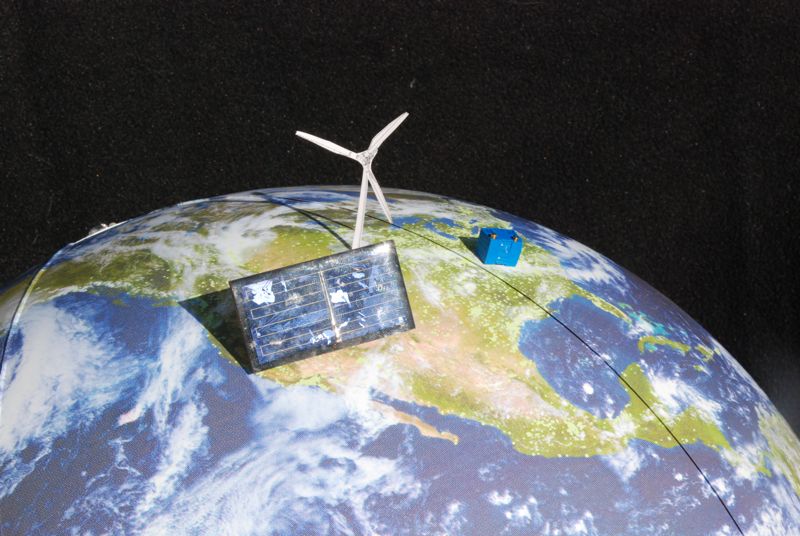"The Lead Acid Battery Sector Is Starting A Bull Run" (CHP; ENS; XIDE)
Words I never thought I'd post....Here's how it turned out for Exide:
We used to call that a "Bear went over the mountain" pattern.
But it was a nice little run.
Here's some lead-acid scuttlebutt via The Oil Drum:
This is a guest post by Tom Murphy. Tom is an associate professor of physics at the University of California, San Diego.
As we look to transition away from fossil fuels, solar and wind are attractive options. Key factors making them compelling are: the inexhaustibility of the source with use (i.e., renewable); their low carbon footprint; and the independence that small-scale distribution can foster (I’ll never put a nuclear plant on my roof, even if it would make me the coolest physicist ever!).
With full-scale solar in the desert southwest, and wind in the plains states, we're going to need a big battery (items not to scale!). But solar and wind suffer a serious problem in that they are not always available. There are windless days, there are sunless nights, and worst of all, there are windless nights. Obviously, this calls for energy storage, allowing us to collect the energy when we can, and use it when we want.
Small-scale off-grid solar and wind installations have been doing this for a long time, typically using lead-acid batteries as the storage medium. I myself have four golf-cart batteries in my garage storing the energy from eight 130 W solar panels, and use these to power the majority of my electricity consumption at home.
We'll keep an eye on the sector, so you don't have to.It’s worth pausing to appreciate this fact. Compare this scheme to the dream source of fusion. Why do people go ga-ga over fusion? Because there is enough deuterium in water (sea water is fine) to provide a seemingly inexhaustible source of energy, and there are no atmospheric emissions in the process. Meanwhile, solar provides a source that will last longer (billions of years), produces even less pollution (no radioactive contamination of containment vessel), and is here today! It’s even affordable enough and low-tech enough to be on my roof and in my garage! People—we have arrived!
Storage works on the small scale, as many stand-aloners can attest. How would it scale up? Can it?
Meeting Requirements
So what would it take? We’re not a nation tolerant of power outages. Those big refrigerators can spoil a lot of food when the electricity drops away. A rule of thumb for remote solar installations is that you should design your storage to last for a minimum of three days with no energy input. Even then, sometimes you will “go dark” in the worst storm of the winter. This does not mean literally three days of total deprivation, but could be four consecutive days at 25% average input, so that you only haul in one day’s worth over a four day period, leaving yourself short by three.
So let’s buy ourselves security and design a battery that can last a week without any new inputs (as before, this is not literally 7 days of zero input, but could be 8 days at 12.5% average input or 10 days at 30% input). This may be able to manage the worst-case “perfect” storm of persistent clouds in the desert Southwest plus weak wind in the Plains.
Let’s also plan ahead and have all of our country’s energy needs met by this system: transportation, heating, industry, etc. The rate at which we currently use energy in all forms in the U.S. is 3 TW. If we transition everything to electricity, we can get by with 2 TW, assuming no growth in demand. Why? Because we currently use two-thirds of our energy supply (or 2 TW) to run heat engines, getting only about 0.6 TW out for useful purposes in the bargain. An electrical system could deliver this same 0.6 TW for only 1 TW of input, considering storage and transmission efficiencies.
Running a 2 TW electrified country for 7 days requires 336 billion kWh of storage. We could also use nuclear power as a baseload to offset a significant portion of the need for storage—perhaps chopping the need in two. This post deals with the narrower topic of what it would take to implement a full-scale renewable-energy battery. Scale the result as you see fit.
Lead-Acid Delivers
I’ll use lead-acid batteries as a baseline. Why? Because lead-acid batteries are the cheapest way to store electricity today. They’re bulky, sloshy, and very heavy, which makes them unsuitable for electric cars or laptop computers. But they’re very efficient, commonly achieving 85% or better energy efficiency in a charge cycle. The technology is well tested, having been around since 1859. And lead is a common element, being the endpoint of the alpha-decay chain of heavy elements like uranium and thorium. Their economic favorability makes lead-acid batteries hands-down the most common battery type in stand-alone renewable systems worldwide....MORE
